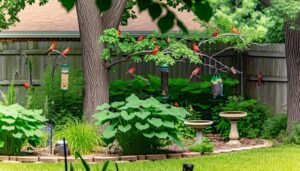7 Key Differences: Cardinal Nest vs Sparrow Nest
When comparing cardinal and sparrow nests, you'll notice distinct differences. Cardinals craft robust, cup-shaped nests from twigs and bark strips, typically 12-24 cm in diameter, hidden in dense foliage.
Sparrows, on the other hand, create finer, dome-shaped nests using grass and feathers, usually 10-15 cm wide, often in urban settings or man-made structures. Cardinals nest in early spring and prefer secluded areas, while sparrows adapt to varied environments, nesting later and frequently reusing their nests.
Explore further to understand how each bird's nesting habits reflect their ecological adaptations for survival.

Key Takeaways
- Cardinals build large, cup-shaped nests in rural areas; sparrows construct smaller, dome-shaped nests in urban environments.
- Cardinal nests are made from twigs, bark strips, and leaves, while sparrows use grass, feathers, and small twigs.
- Cardinals nest in dense shrubbery or low tree branches; sparrows nest in sheltered spots like eaves.
- Cardinals have one nest per breeding season with multiple broods; sparrows may reuse nests and also have multiple broods.
- Cardinal incubation lasts 11-13 days, preferring dense foliage; sparrow incubation ranges from 10-14 days, often incorporating feathers and paper.
Nest Construction Materials
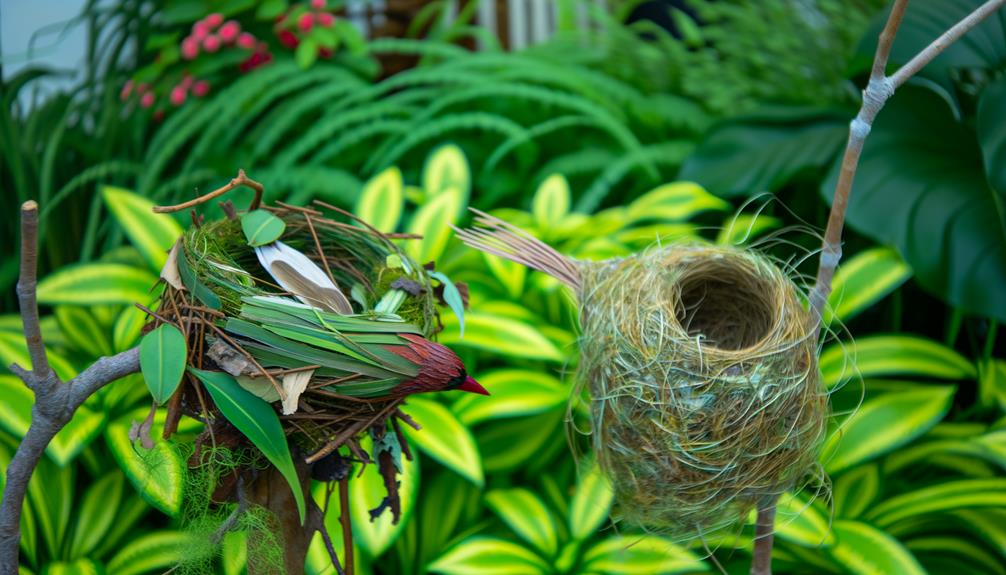
When comparing the nest construction materials of cardinals and sparrows, you'll observe that cardinals primarily utilize twigs, bark strips, and leaves, while sparrows prefer grass, feathers, and small twigs.
Cardinals choose robust twigs and flexible bark strips, creating a strong structure. They incorporate leaves to provide insulation and camouflage.
In contrast, sparrows select finer materials. Grass forms the main framework, while feathers add a soft lining for comfort and temperature regulation. The sparrows' use of small twigs guarantees stability without compromising the nest's lightweight nature.
These distinct choices reflect each species' adaptive strategies to their respective environments, ensuring their nests fulfill specific ecological and survival needs. Understanding these differences enhances your appreciation for avian ingenuity.
Nest Size and Shape
When comparing the nests of cardinals and sparrows, you'll notice distinct differences in structural dimensions and shapes. Cardinals typically build larger, cup-shaped nests, while sparrows construct smaller, dome-shaped ones.
Additionally, the material usage varies, reflecting each species' nesting requirements and environmental adaptations.
Structural Dimensions Comparison
Cardinal nests are typically larger and more robust compared to the smaller and more delicate sparrow nests. You'll notice that cardinal nests measure approximately 12-24 centimeters in diameter and are often constructed at a height ranging from 1.5 to 4.5 meters above ground. Their sturdier structure incorporates a mix of twigs, bark, and leaves, ensuring durability.
In contrast, sparrow nests are generally around 10-15 centimeters in diameter and are built within a lower height range of 1 to 3 meters. These nests tend to use finer materials such as grasses and feathers, resulting in a more fragile composition.
This dimensional variation highlights the adaptability of both species to their respective environments, optimizing their nesting strategies for survival and reproduction.
Typical Nest Shapes
Both cardinal and sparrow nests exhibit distinct shapes that reflect their unique structural and environmental adaptations. You'll notice these differences immediately upon close examination:
- Cardinal Nests: Typically cup-shaped, they're intricately woven to provide stability and camouflage among dense foliage.
- Sparrow Nests: Often dome-shaped with an entrance hole, these nests offer enhanced protection from predators and the elements.
- Size: Cardinal nests generally measure around 3-4 inches in diameter, while sparrow nests are slightly smaller, around 2-3 inches.
- Height Placement: Cardinals prefer mid to low canopy levels, whereas sparrows often nest in lower shrubs or even ground level.
These structural nuances underscore each species' evolutionary strategies and habitat preferences, providing them with the freedom to thrive in their respective environments.
Material Usage Differences
Examining the materials used in nest construction reveals stark contrasts between cardinals and sparrows, highlighting their distinct approaches to building and environmental adaptation. Cardinals typically select twigs, bark strips, and grasses, constructing a sturdy, cup-shaped nest. Their nests measure about 4 inches across and 2 inches deep, providing stability and protection against predators.
In contrast, sparrows mainly use grasses, feathers, and paper, creating a smaller, more flexible structure. Their nests are often 3 inches wide and 1.5 inches deep, reflecting their adaptable and opportunistic nature.
You'll notice sparrow nests are less uniform, adapting to various urban and rural environments.
Location Preferences
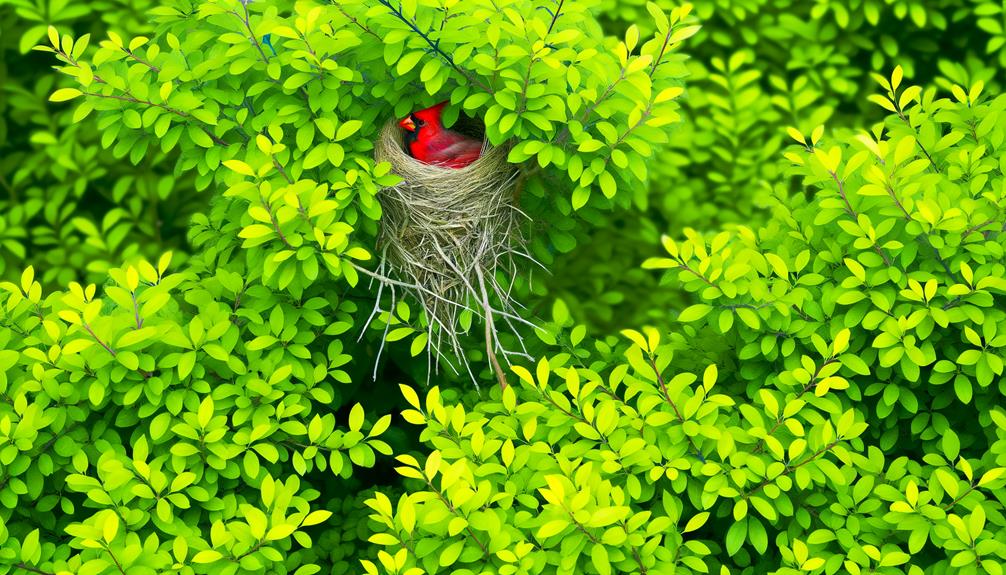
You'll observe that cardinals and sparrows exhibit distinct location preferences for their nests. Cardinals tend to favor rural habitats with dense foliage, while sparrows often choose urban environments.
Additionally, both species consider nest height and proximity to food sources critical factors in site selection.
Urban Vs Rural Habitats
When comparing cardinal and sparrow nests, you'll find that cardinals generally favor rural habitats with dense vegetation, while sparrows are more adaptable, frequently nesting in urban areas.
Cardinals prefer secluded areas for:
- Dense foliage – providing cover and protection.
- Abundant food sources – like seeds and insects found in rural settings.
- Lower human disturbance – ensuring a tranquil nesting environment.
- Proximity to water – aiding in hydration and food availability.
Sparrows, on the other hand, exhibit remarkable adaptability, often nesting in urban landscapes. They exploit:
- Man-made structures – for nesting sites.
- Readily available food – from human activities.
- High tolerance to human presence – allowing them to thrive amidst urban noise.
- Flexible nesting materials – from diverse urban resources.
Both birds demonstrate unique strategies aligned with their habitat preferences.
Nest Height Preferences
Cardinals typically build their nests at mid-height in shrubs or small trees, taking advantage of dense foliage for concealment and protection. You'll notice their preference for nests situated 3 to 10 feet off the ground. This strategic height allows them to avoid ground predators while staying below the canopy's higher, more exposed branches.
In contrast, sparrows exhibit a broader range of nest height preferences. House Sparrows, for instance, often select sites closer to human structures, ranging from ground level up to the eaves of buildings.
Tree Sparrows, however, prefer natural cavities or higher branches, sometimes reaching up to 20 feet.
Proximity to Food Sources
Both cardinal and sparrow nests are strategically placed not only for height but also for their proximity to abundant food sources. You'll notice these birds prefer habitats where foraging is efficient and safe. By analyzing their location preferences, you can see patterns:
- Cardinals often nest near dense shrubbery or wooded areas, favoring places rich in seeds and fruit.
- Sparrows typically choose locations close to human settlements, benefiting from easily accessible grains and insects.
- Cardinals avoid open fields, opting for food sources that are concealed from predators.
- Sparrows are more adaptable, frequently exploiting urban environments where food waste is plentiful.
These preferences highlight their survival strategies, ensuring both species maximize their energy intake while minimizing risk.
Building Techniques
Leveraging innate instincts and environmental cues, both bird species showcase distinct building techniques that reflect their unique nesting requirements. Cardinals construct open cup nests using twigs, bark strips, and grasses. They prefer dense shrubbery or low tree branches, ensuring concealment from predators. You'll observe that they layer materials meticulously, creating a sturdy base.
In contrast, sparrows build compact, dome-shaped nests with an entrance on the side. They utilize grasses, feathers, and even man-made materials. Sparrows often choose sheltered locations like eaves or dense foliage, providing protection from elements and predators. Their nests are less intricate but highly adaptive, allowing quick construction.
These techniques highlight each species' evolutionary adaptations to their habitats and survival strategies.
Seasonal Nesting Habits
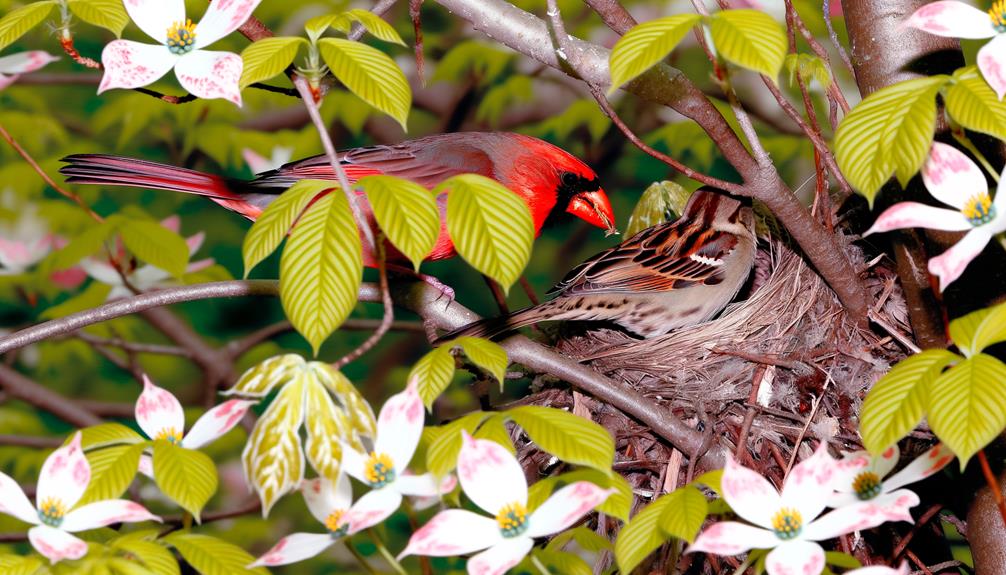
Understanding their distinct building techniques sets the stage for examining how seasonal nesting habits further differentiate these two bird species.
Cardinals and sparrows exhibit unique patterns:
- Cardinals begin nesting in early spring, continuing through late summer. This period allows multiple broods.
- Sparrows, particularly house sparrows, start nesting in late spring, extending into early autumn. They utilize a wide range of urban and rural habitats.
- Cardinals prefer dense foliage, offering concealment and protection during nesting seasons.
- Sparrows adapt to diverse environments, often using man-made structures for their nests.
These seasonal nesting habits reflect each species' adaptation to their environments, ensuring ideal conditions for raising their young.
Predation and Safety
Predation poses significant challenges to both cardinals and sparrows, influencing their nest placement and construction strategies for best safety. You'll find cardinals often choose dense shrubs or low trees, leveraging thick foliage as a natural shield against predators. Sparrows, on the other hand, frequently nest in cavities or man-made structures, reducing accessibility for larger threats. Both species employ specific building materials to enhance structural integrity and camouflage.
| Species | Nest Location | Defensive Strategy |
|---|---|---|
| Cardinals | Dense shrubs, low trees | Use thick foliage |
| Sparrows | Cavities, structures | Utilize hard-to-reach spots |
Cardinals might use twigs, leaves, and grasses to blend their nests, whereas sparrows often incorporate feathers and paper for added concealment. Understanding these techniques can illuminate how each species adapts to their environment's predation pressures.
Nesting Duration
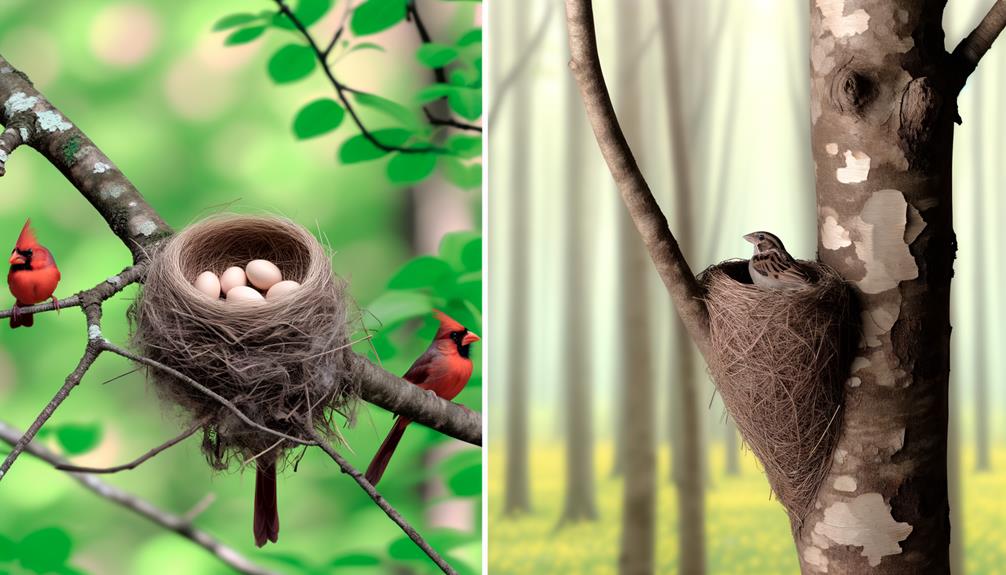
The nesting duration for cardinals and sparrows varies greatly, influenced by factors such as species-specific incubation periods and environmental conditions. Cardinals typically have a nesting duration of 11-13 days for incubation, followed by an additional 9-11 days until the fledglings leave the nest.
Sparrows, on the other hand, demonstrate a slightly different timeline. Sparrows' incubation period ranges from 10-14 days, with nestling periods lasting between 12-15 days.
You'll notice that sparrows generally spend more time in the nest compared to cardinals. These durations can be influenced by temperature, food availability, and predation risks, each playing an essential role in ensuring the successful rearing of their young.
Parental Behavior
Cardinal and sparrow parents exhibit distinct behaviors during the nesting period that optimize the survival and development of their young. Cardinals engage in biparental care, where both the male and female contribute to feeding and protecting the chicks. You'll notice the male often forages for food while the female stays close to the nest.
In contrast, sparrows display a more communal approach. Male sparrows may mate with multiple females and provide less direct care, relying instead on the female's diligence. This divergence in parental investment strategies reflects their adaptive responses to environmental pressures.
Conclusion
In comparing cardinal and sparrow nests, you've cracked nature's intricate blueprints.
Cardials' nests, with their robust, cup-shaped architecture, contrast sharply with the sparrow's more haphazard construction. Location choices reveal their unique survival strategies; cardinals favor dense foliage while sparrows adapt to urban settings.
Observing their meticulous building techniques and seasonal habits, you'll see a delicate dance of life and survival. Both species' parental behaviors highlight their relentless drive to protect and nurture, embodying nature's relentless resilience.





